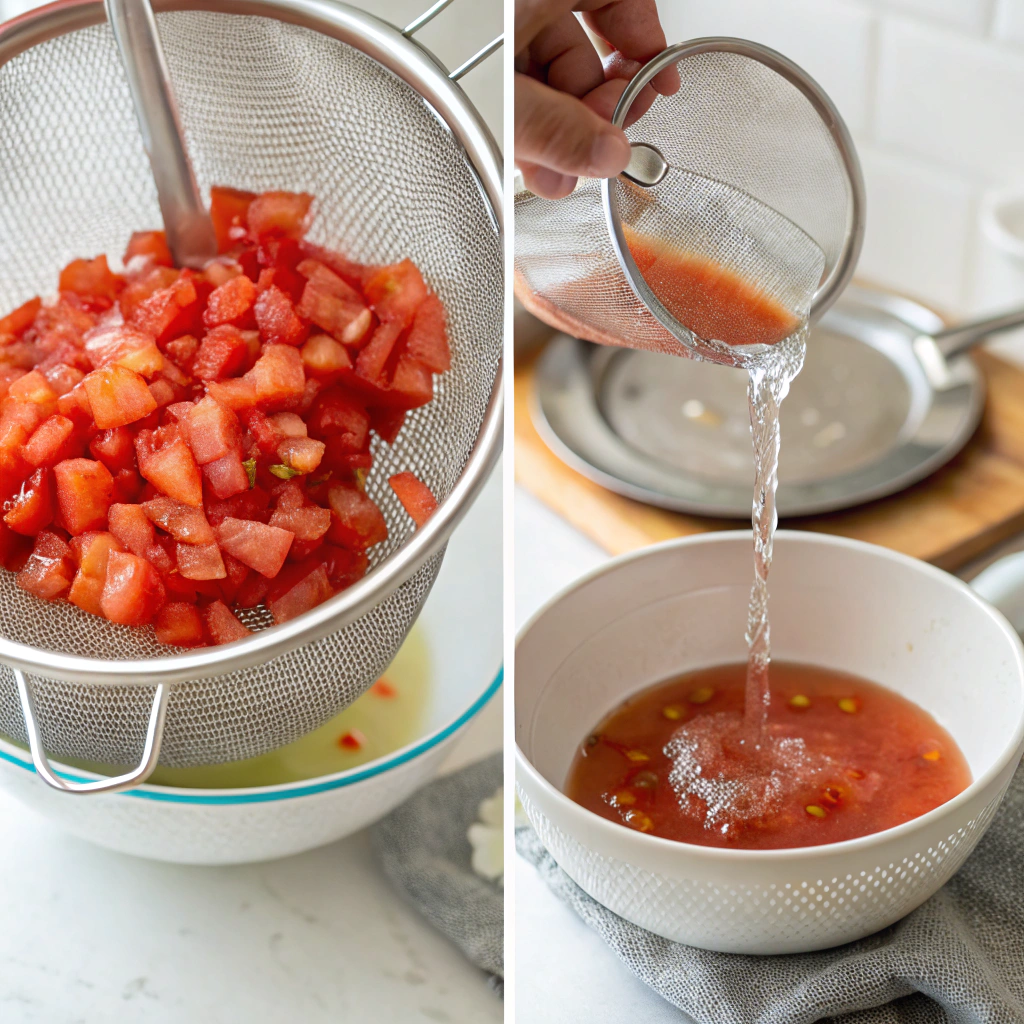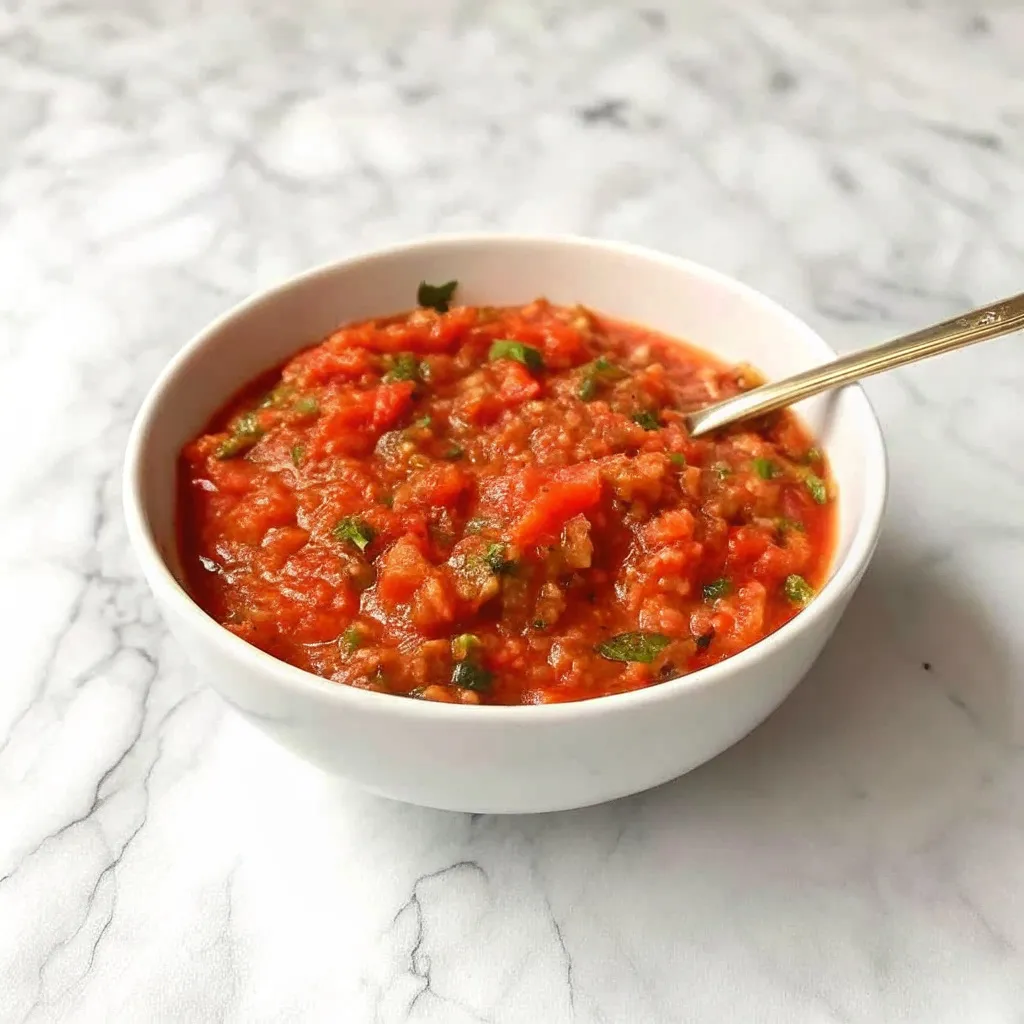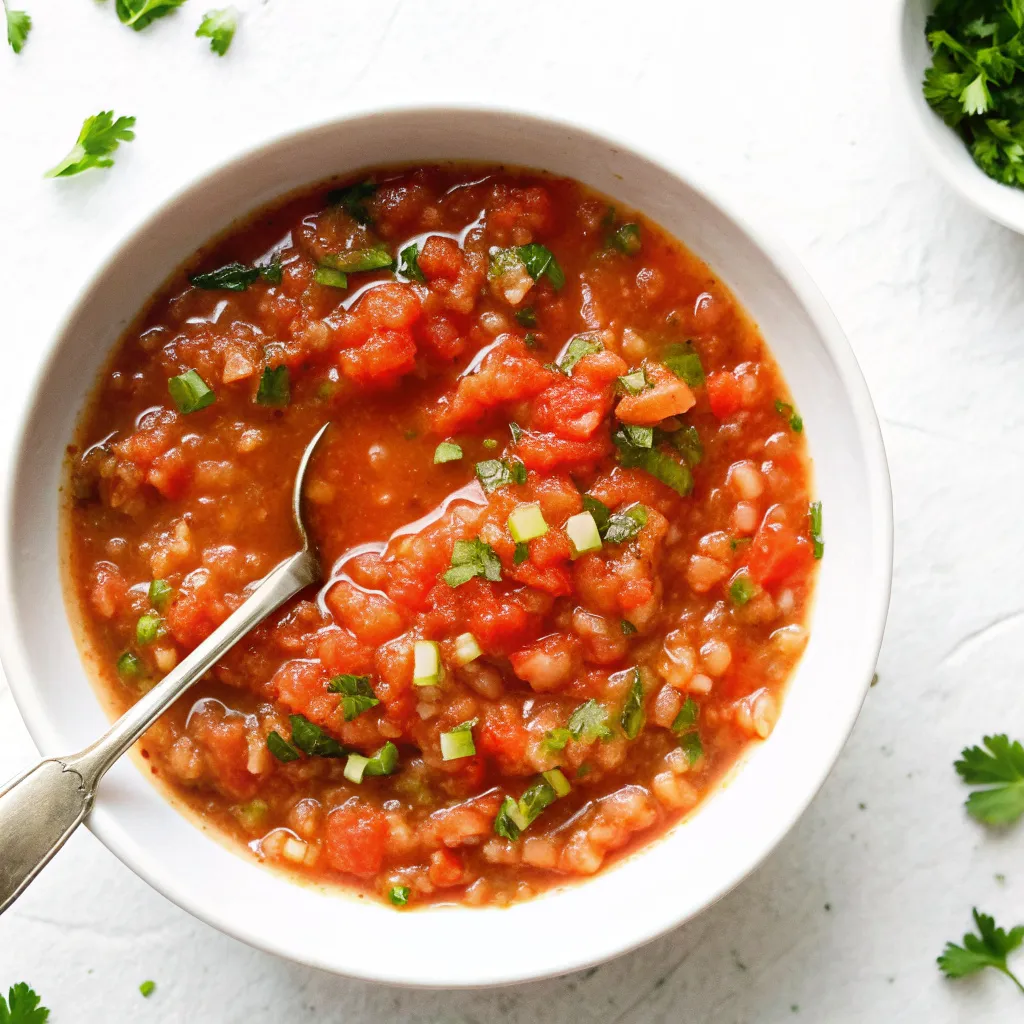Transform ordinary tomatoes into restaurant-quality fresh tomato salsa recipe in just 10 minutes with this foolproof technique that delivers perfect texture and flavor every time. Store-bought salsas often disappoint with their preservative-laden taste and watery consistency, while many homemade versions fall flat due to poor ingredient selection and improper preparation methods. This comprehensive fresh tomato salsa recipe eliminates those common pitfalls by using professional chef techniques that ensure your homemade salsa maintains the perfect balance of fresh, vibrant flavors without the soggy texture that plagues most amateur attempts.
Whether you’re hosting a gathering or simply craving an authentic taste experience, this easy salsa recipe will become your go-to method for creating consistently delicious results that rival any restaurant.
Table of Contents
Why This Fresh Tomato Salsa Recipe Works Every Time
The difference between mediocre and exceptional fresh tomato salsa lies in understanding the science behind proper preparation techniques. Most home cooks struggle with watery, bland results because they skip the crucial draining step that removes excess moisture from fresh tomatoes.
The Secret to Perfect Salsa Texture: Draining Technique
The key to avoiding watery salsa starts with understanding tomato composition. Fresh tomatoes contain approximately 95% water, and when diced, they continue releasing moisture due to cellular breakdown. By salting the diced tomatoes and allowing them to drain for 15-20 minutes, you remove excess liquid while concentrating the natural tomato flavors. This process, called osmosis, draws out water while preserving the firm texture that makes great homemade salsa.
Place your diced tomatoes in a fine-mesh strainer, sprinkle with salt, and let gravity do the work. You’ll be amazed at how much liquid drains away – typically 2-3 tablespoons per cup of tomatoes. This simple step transforms your fresh tomato salsa from a watery disappointment into a restaurant-quality condiment.
Ingredient Quality Makes the Difference
Premium ingredients elevate any homemade salsa recipe from good to extraordinary. Choose tomatoes that yield slightly to pressure but aren’t soft or mushy. Roma tomatoes work exceptionally well due to their lower water content and meaty texture, while beefsteak varieties provide sweetness and substance.
Fresh cilantro should have bright green leaves without yellowing or dark spots. The stems contain concentrated flavor, so don’t discard them entirely – finely chop tender stem portions for added depth. When following the safe fresh produce handling guidelines, always wash all vegetables thoroughly before preparation to ensure food safety.
Flavor Balance: Sweet, Acid, Heat, and Herbs
Professional chefs understand that exceptional fresh tomato salsa requires balancing four fundamental flavor components. The natural sweetness from ripe tomatoes provides the foundation, while fresh lime juice adds essential acidity that brightens all other flavors. Controlled heat from jalapeños or serrano peppers creates complexity without overwhelming, and fresh herbs like cilantro contribute aromatic freshness that ties everything together.
The secret lies in tasting and adjusting throughout preparation. Start with less acid and heat, then gradually increase until you achieve perfect harmony. Remember, you can always add more, but you cannot take away excess once incorporated.
Essential Ingredients for Fresh Tomato Salsa Recipe

Selecting the right ingredients transforms an ordinary homemade salsa into an extraordinary culinary experience. Each component plays a specific role in creating the perfect flavor profile and texture that characterizes restaurant-quality results.
Choosing the Best Tomatoes: Fresh vs. Canned Options
Fresh tomatoes remain the gold standard for superior salsa, but success depends on selecting the right varieties. Roma tomatoes excel due to their dense, meaty texture and lower water content, making them ideal for fresh tomato salsa that won’t become watery. Beefsteak tomatoes offer exceptional sweetness and work well when perfectly ripe, while cherry tomatoes provide concentrated flavor perfect for smaller batches.
For year-round consistency, high-quality canned tomatoes can substitute when fresh options lack flavor or proper ripeness. Choose whole canned tomatoes in juice, drain thoroughly, and dice by hand for better texture control. Consult a comprehensive tomato variety selection and ripeness guide to understand seasonal availability and optimal storage methods.
Herb and Spice Selection Guide
Fresh cilantro provides the distinctive flavor that defines authentic Mexican-style salsa, but proper selection and preparation maximize its impact. Choose bunches with bright green leaves and firm stems, avoiding any with yellowing or slimy sections. Both leaves and tender stem portions contribute flavor, so don’t waste the stems entirely.
For heat, jalapeño peppers offer mild to moderate spiciness with fresh, grassy notes, while serrano peppers provide more intense heat with sharper flavor. Remove seeds and membranes for milder heat, or include them for those who prefer more fire. White or yellow onions provide sharp bite that mellows beautifully, while red onions add color and slightly sweeter flavor.
Smart Substitutions for Dietary Needs
This versatile fresh tomato salsa adapts easily to various dietary requirements and preferences. For those avoiding onions, finely diced green onions or shallots provide similar flavor with less intensity. Mint or parsley can substitute for cilantro when serving those with cilantro aversion, though the flavor profile will shift significantly.
Salt-conscious cooks can reduce sodium by using less salt during the draining process and compensating with additional lime juice and fresh herbs. For heat-sensitive palates, sweet bell peppers provide crunch and color without any spiciness, while maintaining the fresh vegetable texture essential to great salsa.
Step-by-Step Fresh Tomato Salsa Instructions
Follow these detailed instructions to create perfect homemade salsa every time. Each step builds upon the previous one, creating layers of flavor while ensuring optimal texture that won’t disappoint.
Proper Tomato Preparation and Draining Technique
Begin by washing 4-5 medium Roma tomatoes under cold running water, then pat completely dry with paper towels. Remove the core using a sharp paring knife, cutting in a circular motion around the stem end. Dice tomatoes into uniform ¼-inch pieces for consistent texture and even flavor distribution.

Place diced tomatoes in a fine-mesh strainer set over a bowl, then sprinkle with 1 teaspoon kosher salt. Toss gently to distribute salt evenly, then let drain for 15-20 minutes. This crucial step removes excess moisture that would otherwise create watery salsa. You should see significant liquid accumulation in the bowl below – this confirms the process is working correctly.
While tomatoes drain, prepare remaining ingredients. Finely dice ¼ medium white onion, mince 2 garlic cloves, and finely chop ¼ cup fresh cilantro leaves and tender stems. Remove seeds from 1 jalapeño pepper before mincing, or leave seeds for additional heat according to preference.
Mixing and Blending for Ideal Consistency
After draining, gently pat tomatoes with paper towels to remove surface moisture, then transfer to a medium mixing bowl. Add prepared onion, garlic, cilantro, and jalapeño, stirring gently to combine without crushing the tomato pieces.
Squeeze fresh lime juice directly over the mixture – start with juice from 1 large lime, approximately 2 tablespoons. Add ½ teaspoon kosher salt and ¼ teaspoon freshly ground cumin for depth. Fold ingredients together using a large spoon, being careful not to overmix and break down the tomato pieces.
The goal is maintaining distinct vegetable pieces while ensuring even seasoning distribution. This fresh tomato salsa should look colorful and chunky, not mushy or uniform like processed versions.
Taste Testing and Final Adjustments
Allow the mixed salsa to rest for 5 minutes, permitting flavors to meld and develop complexity. Taste carefully, evaluating balance between acid, salt, heat, and freshness. The lime juice should brighten without overwhelming, while salt enhances natural tomato sweetness without being detectible.
Adjust seasoning gradually – add more lime juice for brightness, salt for enhancement, or minced jalapeño for heat. Remember that flavors will continue developing as the salsa rests, so avoid over-seasoning initially. For those planning to serve with Kid-Friendly Salsa Lunch Ideas, consider keeping the heat level mild and preparing a spicier version separately for adults.
Troubleshooting Your Homemade Tomato Salsa
Even experienced cooks encounter occasional challenges when making fresh tomato salsa. Understanding common problems and their solutions ensures consistent success with every batch you prepare.
Fixing Watery or Too-Thick Consistency
Watery salsa typically results from skipping the draining step or using tomatoes with excessive moisture content. If your finished salsa seems too liquid, strain it again for 10-15 minutes, or add finely diced fresh tomatoes that have been properly drained to absorb excess moisture.
Conversely, overly thick salsa can be thinned with small amounts of fresh lime juice or the reserved tomato liquid from the initial draining process. Add liquid gradually, one teaspoon at a time, stirring gently between additions until you achieve desired consistency.
For future batches, remember that different tomato varieties contain varying moisture levels. Adjust draining time accordingly – cherry tomatoes need less time, while very ripe beefsteak tomatoes may require up to 30 minutes for optimal results.
Balancing Flavors: Too Spicy, Bland, or Acidic
Overly spicy fresh tomato salsa can be mellowed by adding more diced tomatoes and onions to dilute the heat, or incorporating a small amount of finely diced cucumber for cooling effect. Dairy products aren’t traditional in salsa, but serving with cooling accompaniments helps balance fiery flavors.
Bland salsa usually lacks sufficient acid or salt. Increase lime juice gradually, tasting between additions, or add a small pinch of salt to enhance natural flavors. Fresh herbs like cilantro also brighten overall taste when added just before serving.
Excessive acidity can be balanced with a tiny pinch of sugar or additional diced tomatoes to provide natural sweetness. Avoid adding too much sugar, as it should enhance rather than sweeten the overall flavor profile.
Common Mistakes and How to Avoid Them
The most frequent error involves using tomatoes that aren’t properly ripe or are past their prime. Underripe tomatoes lack sweetness and flavor complexity, while overripe ones contribute excessive moisture and mushy texture. Choose tomatoes that yield slightly to pressure while maintaining firm structure.
Another common mistake is over-processing ingredients. Hand-chopping maintains texture and visual appeal that food processors cannot achieve. While machines save time, they often create puree-like consistency that resembles jarred salsa rather than fresh, restaurant-quality results.
Finally, many home cooks make salsa too far in advance. While some melding time improves flavor, preparing this homemade salsa more than 4 hours ahead often results in soggy texture and diminished fresh taste that defines excellent salsa.
Storage, Serving, and Recipe Variations
Proper storage techniques and creative serving suggestions maximize your fresh tomato salsa enjoyment while exploring exciting flavor variations that keep this versatile recipe interesting.
Proper Storage Techniques and Shelf Life
Fresh tomato salsa maintains optimal quality for 3-4 days when stored properly in the refrigerator. Transfer to an airtight container immediately after preparation, pressing plastic wrap directly onto the surface before sealing to minimize air exposure and prevent oxidation.
For longer preservation, follow proper salsa preservation techniques for safe canning methods. However, fresh salsa’s texture and flavor are best enjoyed within the first few days of preparation.
Before serving previously stored salsa, drain any accumulated liquid and taste for seasoning adjustments. You may need to add fresh lime juice and cilantro to restore bright, vibrant flavors that can diminish during storage.
Creative Serving Ideas Beyond Chips
While tortilla chips remain the classic pairing, this versatile fresh tomato salsa enhances numerous dishes. Spoon over grilled chicken or fish for a fresh, healthy topping that adds color and flavor without heavy sauces. It pairs beautifully with Seared Ahi Tuna Recipe as a light, refreshing accompaniment that complements the fish’s rich flavor.
Use as a topping for baked potatoes, scrambled eggs, or avocado toast for breakfast or lunch applications. The fresh vegetables and bright acidity cut through rich foods beautifully, providing balance and nutritional value.
For dinner parties, serve alongside Healthy Weeknight Dinner Pairings as a fresh condiment that adds Mexican-inspired flavors to simple grilled meats or roasted vegetables. The versatility makes it suitable for both casual and elegant dining occasions.
Flavor Variations and Seasonal Adaptations
Create exciting variations by incorporating seasonal ingredients or international flavor profiles. Add diced mango or pineapple for tropical sweetness that pairs beautifully with grilled seafood. Corn kernels provide sweetness and textural contrast, especially when using fresh summer corn.
For smokier flavor, char jalapeños over an open flame before dicing, or add a small amount of chipotle peppers for complex heat and depth. Black beans transform this fresh tomato salsa into a heartier side dish suitable for serving with grilled meats.
Mediterranean variations might include diced cucumber, fresh mint, and crumbled feta cheese, while Indian-inspired versions could incorporate fresh ginger, curry leaves, and a touch of garam masala. Each variation maintains the fresh, healthy foundation while exploring different cultural flavor profiles.
Frequently Asked Questions
How long does fresh tomato salsa recipe last in the refrigerator?
Fresh tomato salsa maintains optimal quality for 3-4 days when stored properly in an airtight container in the refrigerator. The texture and flavor are best within the first 48 hours, after which you may notice some softening of vegetables and separation of liquids. Always store with plastic wrap pressed directly onto the surface to minimize air exposure, and drain any accumulated liquid before serving. Signs that salsa has deteriorated include sour smell, slimy texture, or visible mold growth.
Can I make this salsa recipe with canned tomatoes instead of fresh?
Yes, high-quality canned tomatoes can substitute for fresh when seasonal options lack flavor or proper ripeness. Choose whole canned tomatoes in juice rather than crushed varieties for better texture control. Drain thoroughly and dice by hand for optimal consistency. You may need to reduce or eliminate the salting and draining step since canned tomatoes contain less free moisture. The flavor will be slightly different from fresh tomato salsa, with more concentrated tomato taste but less bright, garden-fresh quality.
Why is my homemade tomato salsa watery and how do I fix it?
Watery salsa typically results from skipping the crucial draining step or using tomatoes with excessive moisture content. Fresh tomatoes are 95% water and continue releasing liquid after dicing. To fix watery salsa, strain the mixture for 10-15 minutes to remove excess liquid, or add additional diced and drained tomatoes to absorb moisture. For future batches, always salt diced tomatoes and drain for 15-20 minutes before mixing with other ingredients.
What’s the best way to adjust spice level in fresh salsa?
Control heat level by adjusting the amount and preparation of peppers used. For mild fresh tomato salsa, remove all seeds and membranes from jalapeños before dicing, or substitute sweet bell peppers entirely. For medium heat, include some seeds and membranes, and for spicy versions, use serrano peppers or include more jalapeño seeds. Always start with less heat and gradually increase, as you cannot remove spiciness once added. Taste frequently during adjustment and remember that heat levels intensify as flavors meld.
Can I freeze fresh tomato salsa for later use?
While technically possible, freezing significantly alters the texture of fresh tomato salsa due to the high water content in tomatoes and other vegetables. Upon thawing, the mixture becomes mushy and watery, losing the crisp, fresh texture that defines quality salsa. Frozen salsa works better for cooking applications like soups or sauces rather than as a fresh condiment. For best results, make smaller batches and enjoy within 3-4 days of preparation rather than attempting to freeze.
How do I prevent my fresh tomato salsa from being too salty?
Control saltiness by using kosher salt rather than table salt, which dissolves more readily and can lead to over-salting. When draining tomatoes, use salt sparingly – just enough to draw out moisture without overseasoning. Taste frequently during preparation and remember that you can always add more salt, but removing excess requires diluting the entire batch with additional unsalted ingredients. If salsa becomes too salty, add more diced tomatoes, onions, or a small amount of lime juice to balance the flavors.

Mastering this fresh tomato salsa recipe transforms your kitchen capabilities and provides a foundation for countless culinary adventures. The key technique of properly draining tomatoes ensures perfect texture every time, while using fresh, quality ingredients guarantees restaurant-quality results that surpass any store-bought alternative. Remember that the beauty of homemade salsa lies in its adaptability – start with this proven base recipe, then customize according to your preferences and seasonal ingredient availability.
Whether serving as a simple appetizer with chips or incorporating into elaborate dinner preparations, this versatile fresh tomato salsa delivers consistent, delicious results that will impress family and guests alike. Take the time to practice these techniques, and soon you’ll be creating exceptional salsa that becomes a signature dish in your culinary repertoire.
Print
Fresh Tomato Salsa Recipe: Quick 10-Minute Homemade Guide
- Total Time: 10 minutes
- Yield: 2 cups (8 servings) 1x
- Diet: Vegan
Description
This vibrant Fresh Tomato Salsa is the perfect balance of fresh, zesty flavors that will elevate any meal! Made with ripe tomatoes, crisp onions, and aromatic cilantro, this homemade salsa is infinitely better than store-bought versions. The secret to perfect texture is draining the tomatoes to prevent watery salsa, ensuring every bite is packed with concentrated flavor. Perfect for chips, tacos, grilled meats, or any dish that needs a fresh kick!
Ingredients
- 3½ cups chopped fresh tomatoes (or 28-ounce can diced tomatoes)
- ¼ small onion
- ⅓ cup fresh cilantro
- 2 tablespoons fresh lime juice
- 1 small jalapeño pepper, seeds removed
- ½ teaspoon ground cumin
- ½ teaspoon salt
- ½ teaspoon black pepper
- ½ teaspoon sugar
Instructions
- Drain the Tomatoes: Chop the tomatoes and place them in a fine-mesh strainer for 5 minutes. This crucial step drains excess liquid so the salsa won’t be too watery. Discard the drained liquid.
- Blend the Ingredients: Add the drained tomatoes and all remaining ingredients (onion, cilantro, lime juice, jalapeño, cumin, salt, pepper, and sugar) to a blender or food processor.
- Pulse to Desired Consistency: Pulse the mixture until you reach your preferred texture – chunky for rustic salsa or smooth for a more refined consistency.
- Store and Serve: Transfer to a clean jar or container and refrigerate for at least 30 minutes to allow flavors to meld. Store in the refrigerator for up to one week.
Notes
Pro Tips: For the best flavor, use ripe, in-season tomatoes. Roma tomatoes work particularly well due to their lower water content. Adjust heat level by adding more or less jalapeño, or include the seeds for extra spice. Texture Control: For chunkier salsa, pulse briefly; for smoother salsa, blend longer. Make-Ahead: Salsa tastes even better after sitting for a few hours as flavors develop and meld together. Serving Suggestions: Perfect with tortilla chips, on tacos, grilled chicken, fish, or eggs.
- Prep Time: 10 minutes
- Cook Time: 0 minutes
- Category: Condiment
- Method: No-Cook
- Cuisine: Mexican
Nutrition
- Serving Size: 1/4 cup (1/8th of recipe)
- Calories: 15
- Sugar: 3g
- Sodium: 150mg
- Fat: 0g
- Saturated Fat: 0g
- Unsaturated Fat: 0g
- Trans Fat: 0g
- Carbohydrates: 4g
- Fiber: 1g
- Protein: 1g
- Cholesterol: 0mg

